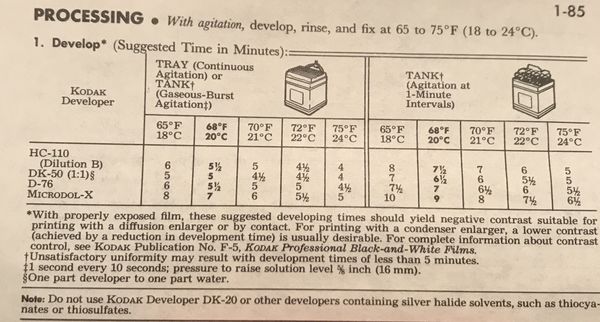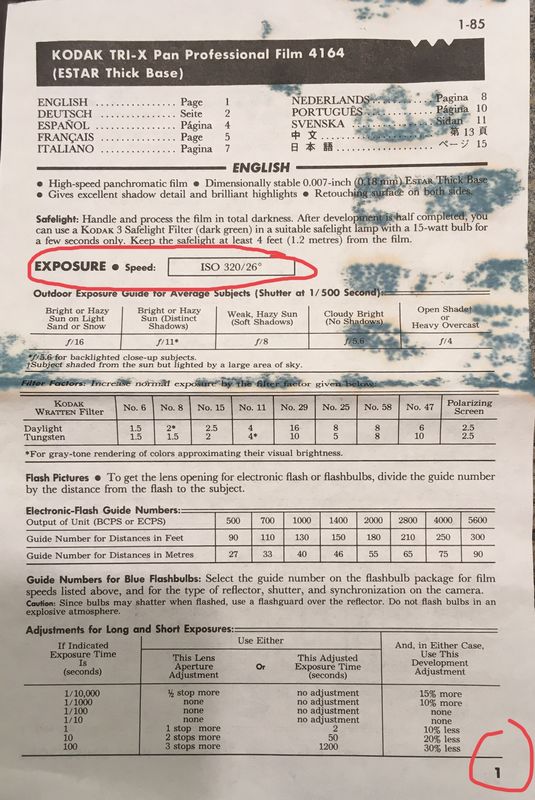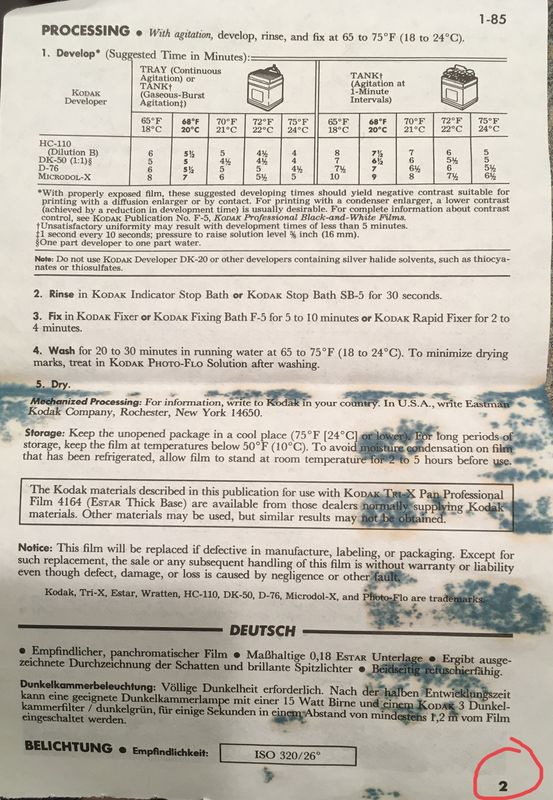Tri X 320 (4x5) Development Time - Film Expiration Date 1988
Jan 11, 2019 10:37:01 #
I have been given a box of 100 sheets of 4x5 Tri X 320 that has an expiration date of 1988. My friend noted that it has been in his freezer for the last 30+ years. When I opened the box, the data sheet states that the development time at 20*C with agitation at 1 minute intervals is 7.5 minutes. The Mass Dev chart notes that sheet Tri X 320 develops at 3.25 minutes for tray & 5.5 minutes for tank. Both charts are using HC110 (B) developer.
Has there been a change in Tri X since 1988 that would account for these differences? Given that the film is freezer stored, for starters, I am planning to use the chart that was in the box with the film. The box had not had its seals broken and the film was in its sealed internal wrappers. Any additional input y'all may have is appreciated.
Has there been a change in Tri X since 1988 that would account for these differences? Given that the film is freezer stored, for starters, I am planning to use the chart that was in the box with the film. The box had not had its seals broken and the film was in its sealed internal wrappers. Any additional input y'all may have is appreciated.
Jan 11, 2019 10:53:29 #
I would assume the data sheet time is for a tank. I personally would try one shot developed at 6.5 minutes and see how the contrast looks. If you print on VC paper the adjustment would not be too hard to make, and you would know what to use for the second development time.
Jan 11, 2019 11:01:54 #
ezslides wrote:
I would assume the data sheet time is for a tank. I personally would try one shot developed at 6.5 minutes and see how the contrast looks. If you print on VC paper the adjustment would not be too hard to make, and you would know what to use for the second development time.
Yes, the data sheet time I quoted is for tank with agitation at 1 minute intervals. There is another for tray/tank with gaseous burst agitation - whatever that is, but I will be using a Patterson tank with a 1 minute then 10 sec/minute agitation scheme
Jan 11, 2019 11:09:26 #
Large volume processors used tanks with nitrogen burst to avoid having multiple people employed agitating the film every minute.
Jan 11, 2019 11:19:14 #
Pablo8
Loc: Nottingham UK.
You have the advantage with 5 x 4 sheet film, in that you can develop one, or more at a time. You should be able to quickly arrive at the best developing time for the rest of the box of 100.
Jan 11, 2019 11:55:00 #
OK, I think I have come up with a testing scheme that will arrive at reasonable results in short order - or at least get me going in the right direction. I will:
1. Load 3 film holders
2. Shoot the even side of the film holder at box speed
3. Shoot the odd side of the film holder at half box speed - over exposed 1 stop - half the numeric shutter speed.
4. Develop each holder's contents separately at 5.5, 6.5 & 7.5 minutes.
5. All shots will be of the same subject taken at essentially the same time with the same aperture settings.
I will have 2 sheets in the tank for each development time, so have to do 3 development cycles and will have 6 different exposure/development times to see what is best. I will update when I have results.
1. Load 3 film holders
2. Shoot the even side of the film holder at box speed
3. Shoot the odd side of the film holder at half box speed - over exposed 1 stop - half the numeric shutter speed.
4. Develop each holder's contents separately at 5.5, 6.5 & 7.5 minutes.
5. All shots will be of the same subject taken at essentially the same time with the same aperture settings.
I will have 2 sheets in the tank for each development time, so have to do 3 development cycles and will have 6 different exposure/development times to see what is best. I will update when I have results.
Jan 11, 2019 16:01:36 #
Jan 11, 2019 21:44:57 #
Ok, so I took a look at the shots. We have 2 sets of 3 shots at:
F/11 & 1/500
F/11 & 1/250
Each set has 1 each processed at 5.5, 6.5 & 7.5 minutes. I am going to have to put them on a light table because, when just holding them up to the light, they all look fine and there is not much difference between them. I may need to do contact prints at the same exposure to see how much difference there is. Bottom line is that they look like good negatives.
F/11 & 1/500
F/11 & 1/250
Each set has 1 each processed at 5.5, 6.5 & 7.5 minutes. I am going to have to put them on a light table because, when just holding them up to the light, they all look fine and there is not much difference between them. I may need to do contact prints at the same exposure to see how much difference there is. Bottom line is that they look like good negatives.
Jan 12, 2019 04:47:59 #
Pablo8
Loc: Nottingham UK.
Good to hear that you are making progress, even with 'old' stock film. Might have to delve deep into my freezer once again. Gets the adrenaline going.
Jan 12, 2019 07:56:23 #
Shutterbug57 wrote:
I have been given a box of 100 sheets of 4x5 Tri X... (show quote)
Sorry I'm late to the party. I'm wondering if you misread the sheet in the box, or got the wrong sheet?
Going back to old Kodak data sheets, and to the HC110 Resource Page, that 7.5 minutes time was Kodak's
recommendation for old Tri-X TX ISO 400, not TXP ISO 320.
The questions, as I understand them, are:
1. Has Kodak Tri-X Pan Professional ISO 320 film changed since 1988?
2. Has Kodak HC110 developer been reformulated since 1988?
3. What is the correct development time for 1988-vintage Tri-X Pan Professional ISO 320
film in 2019-vintage HC110 developer (dilution B at 68F/20C)?
The answers, based on quick research on-line and in two books, appear to be:
1. Definitely. And development times for Tri-X decreased.
2. Maybe. But if so, times for HC110 did not change much, if at all.
3. The HC110 Developer Page (not affiliated with Kodak) recommends
for (old) Tri-X Pan Professional ISO 320 in HC110 dilution B
(method and agitation unknown) 5.5 min @68F/20C.
(assuming HC110 has not been reformulated between 2012 and now.)
In 2002 Kodak changed the composition of a number of films to reduce the silver content.
As a result, "Tri-X is now a semi-flat-grain film with color-dye sensitizers" (Steve Anchell,
Darkroom Cookbook, Third Editon, p . 36). The new films have slightly altered
designations and development times for all the films decreased.
The following table is compiled from the HC110 Developer Resource Page
http://www.covingtoninnovations.com/hc110/
Development times for Kodak Tri-X Films in HC110 (c. 2012) dilution B:
OLD FILM (before 2002) NEW FILM (2002 and after)
Tri-X Pan (TX) 400 7.5 min* Tri-X Pan (400TX) 400 3.7 min **
Tri-X Pan (TX) 1600 16 min data missing---film no longer made?
Tri-X Pan Prof (TXP) 320 5.5 min Tri-X Pan (320TXP) 320 data missing
* -- author states that this time (ISO 400) was "a bit long" and recommends 6-7 minutes.
**--author states and (and I concur) that 3.7 min is too short to be accurately stopped.
He thinks it's an error, but I think they just didn't want to add a new dilution.
Anyway, he recormmends having the strength of dilution B and developing for
6.5 min. It's academic, since this is for the new film, not the one you have.
The other consideration is the developer. HC110 has definitely been reformulated
at least twice. According to the above page, " The syrup is lighter-colored than it
used to be; for a while, in the 1980s, it was quite yellow." According to The
Film Developing Cookbook by Stephen G. Anchell and Bill Troop, HC110
contained pyrocatechin for at least one year. That book contains a formula for an
HC110 prototype taken from a Kodak's US Patent #3,522,969 (not 3,522,060 as
given in the book).
With very old film, you can expect a bit more fog. Fortunately, HC110 is very good
at restraining fog. It might be a good idea to pre-soak to soften the old emulsion.
More info on developing old film:
https://www.lomography.com/magazine/169603-expired-film-developing-ancient-black-and-white-film
Sorry I can't be more definite, but it sounds like you've made some progress.
Jan 12, 2019 08:23:08 #
Bipod wrote:
Sorry I'm late to the party. I'm wondering if y... (show quote)
Thanks for the info. I presoaked the film, but I usually do that anyway, so normal workflow.
Here is the sheet that was in the box. The box notes a 1988 expiration date. The sheet states ISO 320 on pg. 1 and the time table is on pg. 2.
After spending some time on the light table and reversing the shots with my iPad, 7.5 minutes worked the best at metered exposure. I will note that the washing time recommended on the sheet is longer than that on the Mass Dev chart. I used my normal 10 min and noted that corner where the drips fall off was a bit sticky. For production shots, not just test shots, I will extend the wash to 20 min.
Jan 12, 2019 17:15:24 #
Shutterbug57 wrote:
Thanks for the info. I presoaked the film, but I u... (show quote)
Thanks for posting the sheet. That's very interesting -- I can't explain it. 7.5 minutes could be correct
(for 1980s-vintage HC110 -- perhaps for current HC110 as well). Seeing is believing.
20 minutes of washing means lot of wet-time (especially with a pre-soak). As I'm sure you know,
ideally total wet time should be kept under 20 minutes (esp. if a non-hardening fixer is used).
You might be able to shorten your washing time by using Kodak Hypo Clearing Agent (HCA),
if you're not already doing that. It's inexpensive or you can make your own (as I do):
Water at 125F/52C 750 ml
Sodium SulfIte, 200.0 grams
Sodium bisulfIte*, 50.0 grams
Water to make 1 liter
*--to harden the emulsion.. Omit if you will also be using the solution for paper.
"Dilute 1:9 for use. After fixing, rinse the print for 1 minute in running water, then transfer to HCA."
WATER HCA (with agitation) FINAL RUNNING WATER
SW paper 1 min 2 min 10 min
DW paper 1 min 3 min 20 min
Film 30 sec 1-2 min 5 min
Source: Steven Anschell, Darkroom Cookbook, Third Edition, p. 312.
You could try exposing one sheet and then cutting it into strips and developing each for a
different time. That would eliminate exposure as a variable.
Determining normal development time would be a lot easier if you had a densiometer. Perhaps
you could borrow one? The best book I know on sensiometry is Beyond the Zone System
Fourth Edition (1998), by Phil Davis. Worth tracking down if you haven't seen it.
Some random thoughts:
Plain hypo will work with this film, but fast fixer will reduce wet time.
I don't know if you do a quick rinse between stop and fixer, but it's not a bad idea, esp. if you're using
fast fixer and developing a lot of sheets.
Be careful not to exhaust your developer or fixer -- it's easy to do that with sheet film.
(I only mention all this because extra care is needed when working with an unfamiliar film.)
Jan 12, 2019 19:38:02 #
Personally, I would not recommend using film that is 30 some years old for anythg important. There might be a significent loss of speed and an unacceptable level of fog regardless of the developer you use. You don't know at what point it was frozen, if it was defrosted at any point in time. Not many folks keep film in their freezer for 30 years. Kodak issued recommendations for freezer storage up to 12 months.
You are going to invest time is shooting and processing the film. You have to determine whether or not the time and effort is worth it if the results are substandard due to its age.
If you are a large format user, there are still some excellent current films in production such as Kodak T-Max and a number if Ilford products.
I may have a PDF in my files- I will post it for you.
You are going to invest time is shooting and processing the film. You have to determine whether or not the time and effort is worth it if the results are substandard due to its age.
If you are a large format user, there are still some excellent current films in production such as Kodak T-Max and a number if Ilford products.
I may have a PDF in my files- I will post it for you.
Jan 12, 2019 20:18:09 #
E.L.. Shapiro wrote:
Personally, I would not recommend using film that ... (show quote)
You may be right, but for 100 free sheets of film, I figure it is worth shooting a few to see what I get. I agree that I would not do this for a paying gig or something important, but if the film proves to be OK, then I have not problem shooting it for personal projects. My next step is to take it out an shoot it and fresh HP5+ at the same time & settings (adjusted for the ISO difference) to see how it compares.
Jan 13, 2019 07:39:34 #
A wise caution. However, there are many appropriate uses for less-than-perfect film: lens testing, film holder testing,
looking for light leaks, making silouettes or photograms, testing fixer, etc.
To my parsimonious way of thinking, it's a shame to use brand new, top quality film for such purposes.
looking for light leaks, making silouettes or photograms, testing fixer, etc.
To my parsimonious way of thinking, it's a shame to use brand new, top quality film for such purposes.
If you want to reply, then register here. Registration is free and your account is created instantly, so you can post right away.




